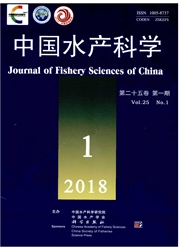

 中文摘要:
中文摘要:
室内水槽实验条件下研究了许氏平鲉(Sebastes schlegelii)幼鱼(15.24 g±2.9 g)在不同光照条件下对3种人工遮蔽物的行为反应。在此基础上,通过7周的养殖实验研究了不同放养密度下(800 ind/m3,1 200 ind/m3,1 600 ind/m3),隐蔽物、投喂频率(1次/d、2次/d、3次/d、4次/d)对许氏平鲉幼鱼(0.50 g±0.02 g)生长、摄食和行为的影响。结果表明:1)实验采用的3种隐蔽物对许氏平鲉幼鱼均有明显的诱集作用,其中扇贝笼改造的隐蔽物S1诱集效果最好。2)遮光条件可以提高隐蔽物区域幼鱼的分布率,但与自然光处理组差异不显著(P〉0.05)。3)在实验设定的密度范围内,许氏平鲉幼鱼的终末体重、日增重率、特定生长率随密度的增大而升高。无隐蔽物条件下,低密度组的日增重率和特定生长率与中高密度组差异显著(P〈0.05),终末体重则显著低于高密度组(P〈0.05);隐蔽物的设置显著提高了中、低密度组许氏平鲉幼鱼的终末体重(P〈0.05),高密度组幼鱼的特定生长率和饲料转换率也有显著提高(P〈0.05)。4)放养密度和隐蔽物对于许氏平鲉幼鱼的生长离散影响显著(P〈0.05),随着放养密度的增大,幼鱼的体重变异系数呈逐渐增大趋势;相同放养密度下,放置隐蔽物的各组幼鱼生长离散均小于未放置组,其中低密度组间差异极显著(P〈0.01),中密度组间差异显著(P〈0.05)。5)3种放养密度下饱食投喂频率为1次/d处理组幼鱼的体重变异系数显著大于其他各组(P〈0.05),饱食投喂频率大于2次/d时,各处理组幼鱼生长离散无显著差异(P〉0.05)。研究结果表明,对于体重0.5~5.8 g的许氏平鲉幼鱼,当放养密度为1 200 ind/m3条件时,通过投放人工隐蔽物,选取2次/d的饱食投喂频率,可显著降低生长离散水平,并使幼鱼获得较好的生长。本研究旨在为许氏平鲉健康苗种培育及规模化生产
 英文摘要:
英文摘要:
We evaluated the behavioral response of Sebastes schlegelii(15.24 g±2.9 g) to three kinds of artificial shelters under different lighting conditions. Additionally, we evaluated the effect of rearing density(800 ind/m3, 1 200 ind/m3, and 1 600 ind/m3), artificial shelter type, and feeding frequency(1, 2, 3, or 4 mealsper day)on the growth, feed consumption, and behavior of juvenile S. schlegelii(0.50 g±0.02 g) in a 7-week net cage culture experiment. Juvenile S. schlegelii were attracted to all 3 artificial shelters types, but particularly to the shelters constructed of scallop cages(S1). The association of fish with the artificial shelters increased under dark conditions, but there was no significant difference(P〉0.05) in their distribution compared to those held under natural light. As density increased, the final weight, daily weight growth rate(DWGR), and specific growth rate(SGR) all increased. For fish reared in the no shelter group, the DWGR and SGR of the low density group was significant lower than for the medium and high density groups(P〈0.05). Additionally, the final weight was significant lower than in the high density group(P〈0.05).The availability of artificial shelters was associated with a significant increase in the final weight in the low and medium density groups compared to the control groups(P〈0.05). Additionally, there was a significant increase in the SGR and FCR in the high density group when shelters were provided(P〈0.05). Stocking density and shelter type had a significant effect on the coefficient of variation for body weight(CVBW) in juvenile S. schlegelii(P〈0.05) whereby CVBW increased with stocking density. The presence of shelters was associated with a lower CVBW than in the absence of shelters. The difference was very significant between low and medium density groups(P〈0.01), and significant between the medium and high density groups(P〈0.05). For all rearing densities, a feeding frequency of once per d
 同期刊论文项目
同期刊论文项目
 同项目期刊论文
同项目期刊论文
 Lack of population genetic differentiation of a marine ovoviviparous fish Sebastes schlegelii in Nor
Lack of population genetic differentiation of a marine ovoviviparous fish Sebastes schlegelii in Nor Use of calcein and alizarin red S for immersion marking of black rockfish Sebastes schlegelii juveni
Use of calcein and alizarin red S for immersion marking of black rockfish Sebastes schlegelii juveni Use of tetracycline hydrochloride and alizarin complexone for immersion marking black rockfish Sebas
Use of tetracycline hydrochloride and alizarin complexone for immersion marking black rockfish Sebas AFLP markers suggest low population genetic differentiation of the black rock fishSebastes schlegeli
AFLP markers suggest low population genetic differentiation of the black rock fishSebastes schlegeli Special structure of mitochondrial DNA control region and phylogenetic relationship among individual
Special structure of mitochondrial DNA control region and phylogenetic relationship among individual Isolation and characterization of nine polymorphic microsatellite markers of the marbled rockfish Se
Isolation and characterization of nine polymorphic microsatellite markers of the marbled rockfish Se The complete mitochondrial genome of the marbled rockfish Sebastiscus marmoratus (Scorpaeniformes, S
The complete mitochondrial genome of the marbled rockfish Sebastiscus marmoratus (Scorpaeniformes, S Vertebral deformity in hatchery-reared and wild-caught juvenile Japanese flounder Paralichthys oliva
Vertebral deformity in hatchery-reared and wild-caught juvenile Japanese flounder Paralichthys oliva Use of calcein and alizarin red S for immersion making of black rockfish Sebastes schlegelii juvenil
Use of calcein and alizarin red S for immersion making of black rockfish Sebastes schlegelii juvenil 期刊信息
期刊信息
